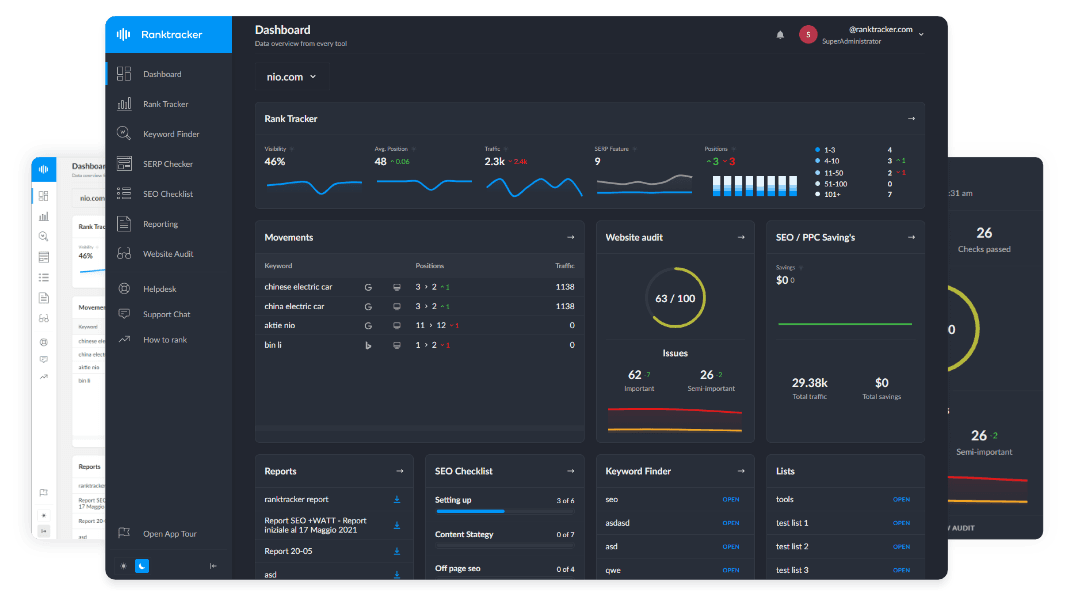Intro
Ever wondered why prospective buyers visit your site but vanish without spending a dime? Attracting visitors to your site is just half the equation. The true win is having the power to turn those visitors into actual business results. Savvy companies understand that bridging the gap between visitors and buyers takes more than looks—it takes a solid conversion strategy.
Let's discuss how to increase website conversion by learning to use psychological triggers and optimization strategies.
The Science Behind Successful Website Conversions
First of all, what is website conversion? It's basically turning random visitors into people who do something useful on your website. Those actions can be buying something, subscribing to a newsletter, downloading something interesting, or seeking a consultation.
This process involves both analytical tools and strategic thinking. While most businesses use popular platforms like SEMrush for conversion analysis, looking into SEMrush alternatives can offer new insights and expert features that may serve your particular conversion tracking better. These alternatives provide unique insights into keyword performance and competitor strategy that can help guide your conversion optimization efforts.
You know what's wonderful about web conversion? It improves return on investment and impacts your wallet in a good way. Even minor adjustments to conversion rates can bring a welcome little addition to your bottom line without spending additional dollars on marketing. That's why conversion rate optimization website strategies are among the best marketing bargains out there these days for any business. And quality CRO marketing is all about using data insights to get the most out of the traffic you already have.
Decoding Your Audience for Maximum Conversion Impact
The secret to any successful conversion strategy is knowing your audience well. This is more than a mere set of demographics and goes on to include psychographics, behavioral patterns, and most importantly, key pain points that drive decision-making.
Keep in mind that improving conversion rates begins with optimizing your knowledge of what drives your particular audience to take action. But audience research must be aimed at determining the purpose of every visit to your site. Some of the people visiting your site may be attempting to find a solution to something, and others may be looking around before they purchase something.
To help people willing to buy, a quick checkout process and some great discounts can inspire them to make the move. But for those who are merely researching, some good educational content and trust markers may get them a bit closer to making a buying decision.
Crafting Frictionless User Experiences That Convert

The All-in-One Platform for Effective SEO
Behind every successful business is a strong SEO campaign. But with countless optimization tools and techniques out there to choose from, it can be hard to know where to start. Well, fear no more, cause I've got just the thing to help. Presenting the Ranktracker all-in-one platform for effective SEO
We have finally opened registration to Ranktracker absolutely free!
Create a free accountOr Sign in using your credentials
User experience design is a big deal when it comes to getting those conversions on your site. It has been studied that good UX can increase conversion rates by up to 400%, making it a very important part of any optimization strategy. Your attention should be focused on making the user experience as smooth and seamless as possible, so that they will be motivated to make a purchase.
Key features of UX for conversions are quick page loading, simple navigation, mobile friendliness, and effective information architecture. You should focus on these features based on what your users want. For instance, consider adjusting your navigation menu if you notice it increases cognitive load and prevents your users from converting.
Visual hierarchy is also paramount when you need to focus attention on certain elements, such as calls to action. Employing strategic contrast, size, color, and white space, you can have a visual flow that drives visitors to conversion points.
Using SEO to Attract High-Converting Traffic
With a strategic SEO plan, you can attract people who are already looking to buy something. Below are the ways through which you can optimize conversion potential via SEO:
- Opt for high-intent phrases that convey buying intent, like "best [product] for [particular need]" or "purchase [product] online," instead of general information terms that bring in casual browsers.
- Optimize for buyer journey phases by creating content that addresses different phases of conversion, beginning with awareness-stage informative content and moving toward decision-stage comparison guides that organically drive to your solutions.
- Focus on local SEO where feasible because location-based search is bound to have instant buy intent and greater conversion potential.
- Improve page loading speed, make pages mobile-friendly, refresh schema markup, and correct other technical SEO problems to enhance rankings and UX.
At the same time, explain how your products fit the equation. Meta titles and descriptions also demand attention, as they communicate value propositions and help attract qualified users. Overall, this focused strategy guarantees your SEO brings leads and not just visitors.
Designing Irresistible Calls to Action That Drive Results
Your calls to action are the bridge between visitor interest and actual conversions. Good CTA design is a combination of psychology, visual impact, and strategic positioning to maximize response rate. Here's how you can create impactful CTAs:
- Employ contrasting colors that are highly legible over your background in order to get maximum visibility and instant attention.
- Create buttons large enough to be click-friendly. Big buttons are strong visual statements and enhance mobile usability.
- Place CTAs in highly visible locations like above the fold, at content endings, or following quality information to get the most engagement. Place them where users expect to see the next steps.
- Make buttons pop by using shadows, borders, or cool hover effects. These little touches add some depth and get people to click on them more.
- Instill scarcity and urgency through words such as "Limited time" or "Don't miss out" to trigger fear of missing out. This psychological phenomenon facilitates quicker decision-making.
- Customize messages to unique audience segments and their challenges to maximize relevance and engagement. Themed CTAs are far superior to generic CTAs.
Building Trust Through Social Proof and Credibility Signals
In an online world where physical visits are not an option, trust becomes a vital factor in web conversions. Your customers must be assured that your company is real and that your service or products are as they are presented. Some good trust factors are customer reviews, testimonials, case studies, security badges, and industry certifications.
When your potential customers can see that other people have had positive experiences with your company, they are far less likely to have any worries about doing the same. Displaying actual customer feedback, particularly with photos and details, can do a lot to boost conversion rate. Just ensure that you place these trust signals in places where individuals may feel a bit uncertain in the process to maximize the impact.
Perfecting Your Approach Through Systematic Testing
A/B testing is the scientific method for web conversions and facilitates data-driven decision making. But, effective A/B testing needs to be done methodically.
Begin by isolating factors with a high conversion influence, such as headlines, CTAs, forms, or prices. Formulate hypotheses regarding how adjustments will enhance performance, and then formulate tests isolating those factors.
When testing, avoid common mistakes, like:
- Testing multiple variables together
- Not segmenting test results by user type
- Calling it off a bit too early
And don't forget, you must have a routine test program in effect. This way, you can keep refining your site for improved conversion performance.
Implementing Data-Driven Optimization Cycles
Website conversion analysis is not a one-off job; it requires you to constantly measure, learn, and optimize. The top companies have frequent cycles of analysis and optimization that continue to build on their conversion rates year after year.
The All-in-One Platform for Effective SEO
Behind every successful business is a strong SEO campaign. But with countless optimization tools and techniques out there to choose from, it can be hard to know where to start. Well, fear no more, cause I've got just the thing to help. Presenting the Ranktracker all-in-one platform for effective SEO
We have finally opened registration to Ranktracker absolutely free!
Create a free accountOr Sign in using your credentials
Contemporary CRO marketing prioritizes this iterative process in which every successive round builds upon learnings from past rounds to power compounding gains. It starts with comprehensive data collection through mediums such as Google Analytics, heatmaps, and session recordings to gain a profound understanding of user behavior.
After data has been gathered, looking for patterns and opportunities comes next. Identify the most frequent drop-off points in your conversion funnel, the most frequently visited exit pages, or the actions of users that show confusion or uncertainty.
After you've run some tests, seriously consider how they're performing against the original metrics to identify what works and what needs improvement.
Conclusion
Learning about ways to increase website conversion rates turns your web presence into a money-making machine. The methods described are a master plan for turning website traffic into repeat business. Success lies in identifying your targeted audience, reducing friction points, and testing your strategy on a continuous basis. Don't let customers get away—implement these tested techniques on your website today and see your converting website bringing the results your business needs. Your success is in your hands.

